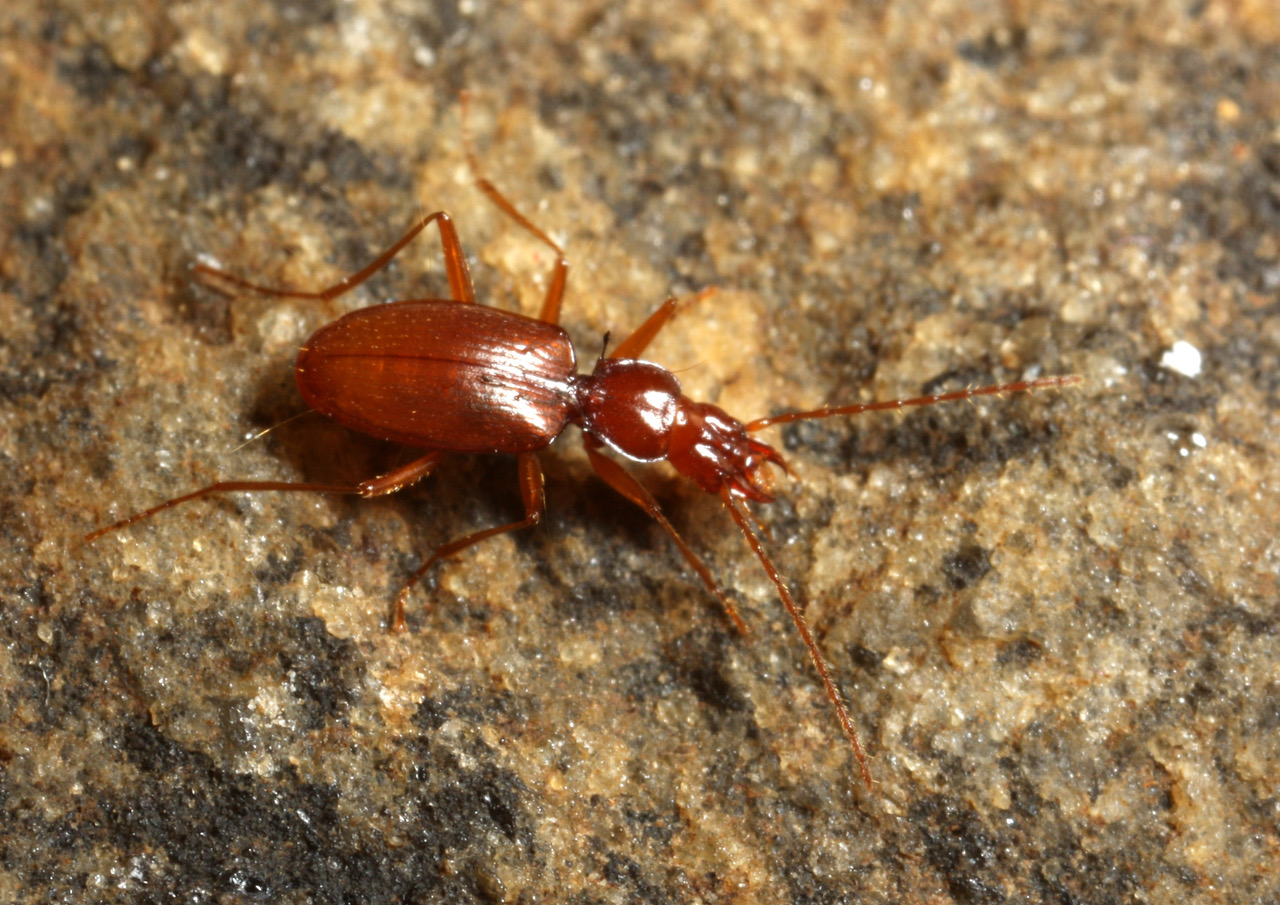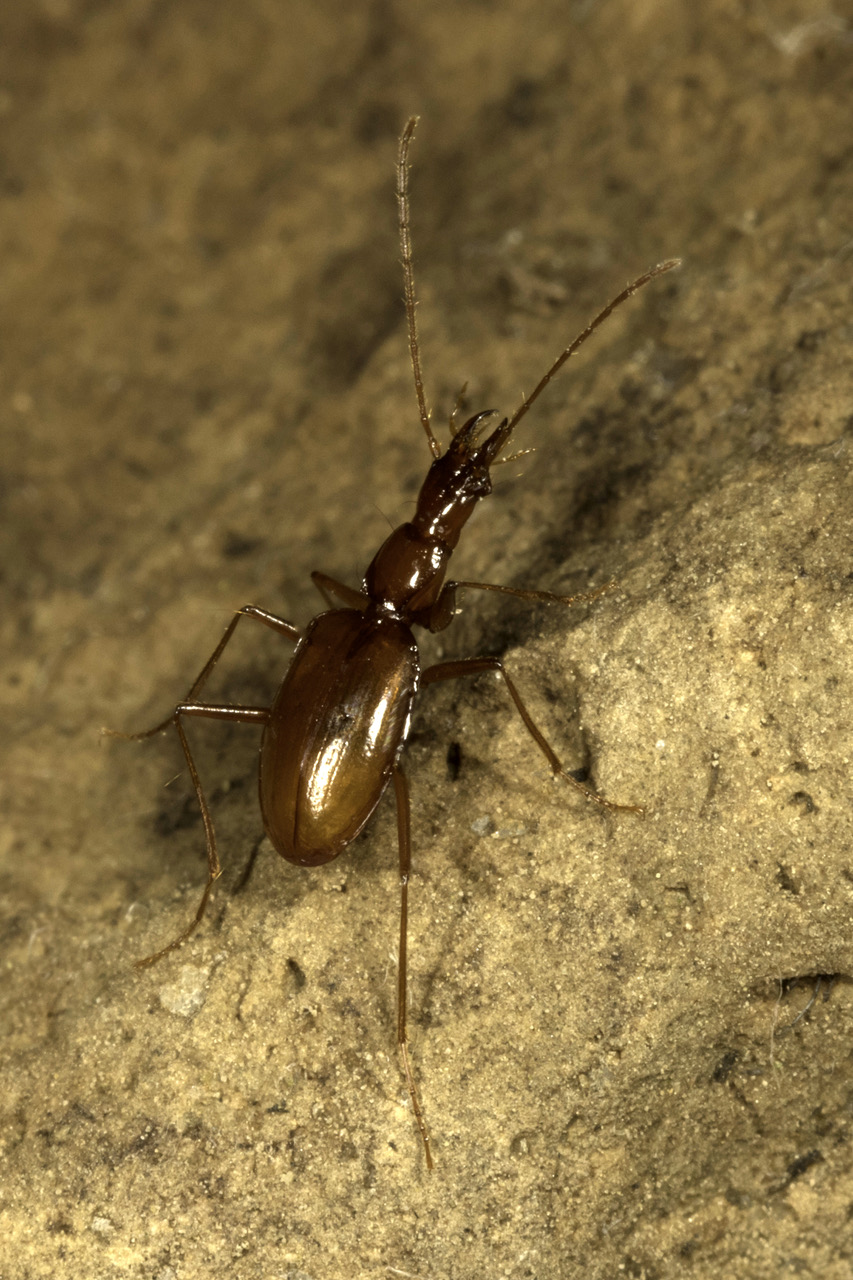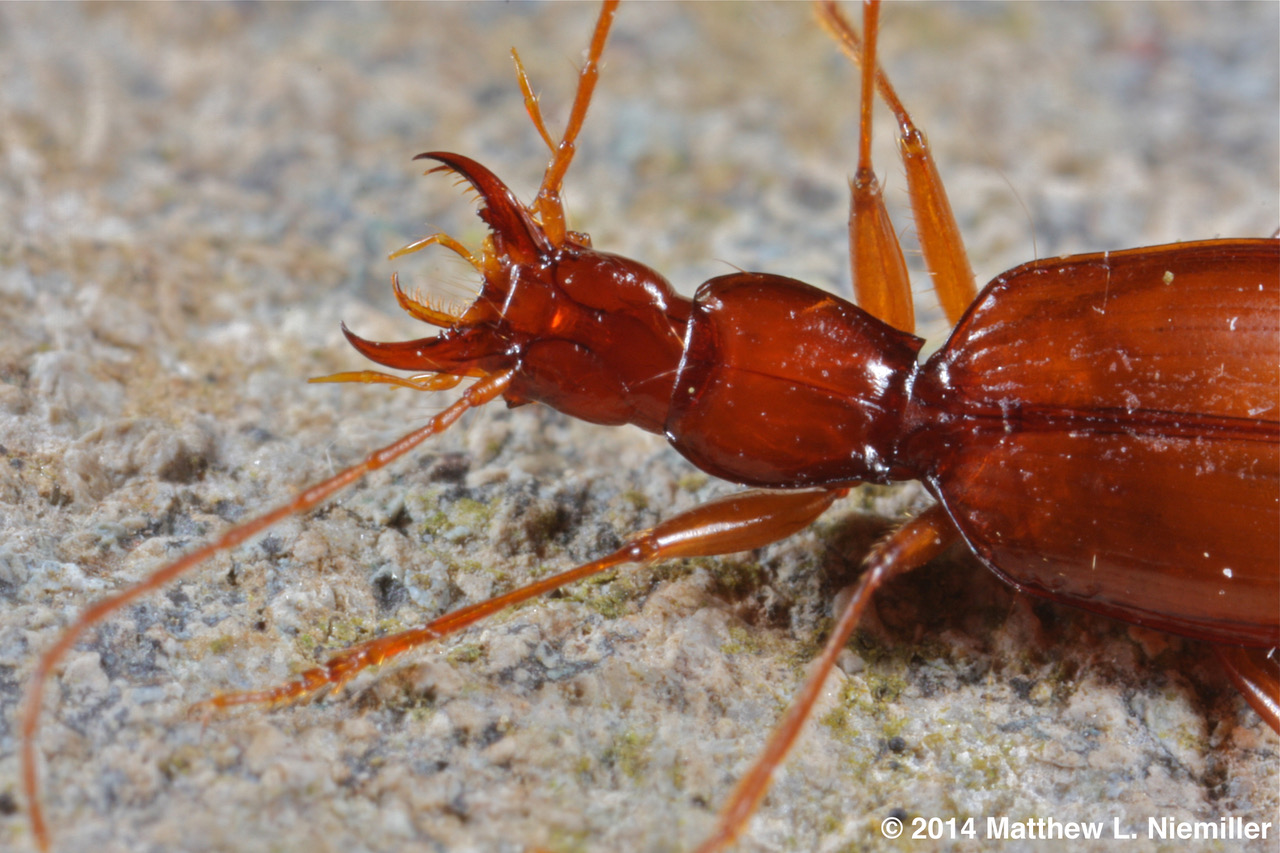Cave Animal of the Year
Welcome to the USA Cave Animal of the Year for 2021!
We want to help increase awareness of the amazing creatures that live underground by featuring a different cave animal each year!
This is the second year for the USA Cave Animal of the Year Program. The 2020 Cave Animal of the year is here.
Why pay attention to cave animals?
We marvel at the beauty of caves, but many people don’t think about those caves being home to an amazing diversity of animals. Some of these animals have interesting adaptations to live in a world of complete darkness and often scant food resources. Worldwide, there are many species of animals that live in caves. Cave Animal of the Year seeks to increase awareness of these fascinating animals and the importance of caves as their homes. For 2021, countries that participate in this program decided to all select cave beetles to celebrate the International Year of Cave and Karst.

Figure 1. This Pseudanophthalmus cave beetle is found in Tennessee. Photo by Matthew Niemiller.
Meet our USA Cave Animal of the Year 2021
The USA Cave Animal of the Year for 2021 is the cave ground beetle, specifically cave beetles in the genus Pseudanophthalmus. They are found throughout much of the Appalachians and Interior Low Plateau karst regions of the eastern United States.
Cave ground beetles are small beetles in the family Carabidae. Many beetles live and can be found in caves. However, cave ground beetles are troglobitic, which means that they are specialized for living in subterranean habitats, including caves. Pseudanophthalmus is the most diverse group of cave beetles in the United States with over 140 described species and at least 80 species new to science that are awaiting taxonomic description.
Getting to Know Cave Ground Beetles
Cave ground beetles are a diverse group of generally small (3–7.5 mm) beetles that are commonly encountered by cavers. These unique beetles lack eyes and flight wings and are depigmented (generally amber in color). They generally have long, slender bodies and elongate legs and antennae. Most species have converged on a similar set of morphological adaptations for living in the darkness of caves and are exceedingly difficult to identify to species based on their external appearance.
Cave ground beetles include more than 180 species in the family Carabidae within the genera Ameroduvalis, Anillaspis, Anillinus, Atelothrus, Catopocerus, Darlingtonea, Horologion, Neaphaenops, Nelsonites, Pseudanophthalmus, Rhadine, and Xenotrechus. Most of this diversity occurs within the genus Pseudanophthalmus, with 145 described species. Cave ground beetles are one of the top predators in terrestrial cave ecosystems.
Are All Beetles Found in Caves Considered Troglobitic?
With more than 400,000 described species, it is not surprising that many species of beetles can be found in caves. Some species accidentally wander or get washed into cave systems from the surface. Others are common in caves but also are common on the forest floor or in other surface habitats. Some species are guanophiles that feed on the guano of bats, raccoons, and other mammals. However, the truly troglobitic species, such as Pseudanophthalmus cave beetles, are adapted for a life in complete darkness and are found almost entirely in subterranean habitats.
[image]
Figure 2. This cave beetle is from Breckinridge County, Kentucky.

Where Can I Find Cave Ground Beetles?
Cave ground beetles are known from caves and other subterranean habitats throughout the Appalachians and Interior Low Plateau karst regions but are also known from the Edwards Plateau and Balcones Escarpment, Ozark Highlands, California, and the Hawaiian Islands. Pseudanophthlamus cave beetles are known from cave systems in 10 states. Although cave ground beetles are known from karst regions throughout the country, most species have very small ranges and are known from just a few cave systems, including several that have been documented from just a single cave (i.e., single-site endemics). However, it is not uncommon to find more than one species in a cave system in parts of Alabama, Georgia, Kentucky, Tennessee, and Virginia.
Cave ground beetles are most often encountered as the move along riparian zones along cave streams or in other areas where organic material and their prey have concentrated. They can be found actively searching for prey on silt and mud banks as well as underneath and within boulder and cobble along cave streams. Cave ground beetles have even been observed on the ceilings of passages with active streams. Cave ground beetles are small and can be difficult to find to the untrained eye.
What Do Cave Ground Beetles Eat?
All cave ground beetles, like most other carabid beetles, are predatory. They likely feed on the eggs of other insects as well as springtails, millipedes, and other arthropods, as well as small annelid worms that live in the silt and mud along the banks of cave streams. Cave ground beetles also have been observed scavenging on the carcass of a dead crayfish.
Protecting Cave Ground Beetles
Because many cave ground beetle species have exceptionally small ranges (e.g., single-site endemics) they are at an increased risk of extinction. Like other small invertebrates that occur in caves, they are vulnerable to any threats that result in the degradation or loss of critical habitat, such as pollution, mining, and flooding of caves associated with impoundments.

Figure 3. This closeup of a beetle shows the head well.
Subterranean Ecosystems
Subterranean ecosystems are often divided into major ecological zones that differ in abiotic factors, such as light, temperature, and humidity. These factors influence the types and numbers of organisms that occur in a given ecological zone. Caves are the most well-known examples of subterranean habitats. Caves can be divided into three major ecological zones.
The entrance zone marks the boundary between the surface and subterranean habitats and usually contains more species as well as greater variation in abiotic conditions, particularly temperature and humidity, compared to other zones. This zone is confined to the immediate area around cave entrances where light penetrates. Many species of plants and animals can be found in the entrance zone.
The transition zone (also called the twilight zone), marks the transition from the surface to subterranean habitats and connects the surface-dominated entrance zone with the dark zone. The transition zone is characterized by decreasing levels of light and habitats that are influenced by surface environmental conditions to a lesser extent than the entrance zone. Few plants grow in the transition zone, but many species of animals can exist.
Finally, the dark zone is the section of cave that lacks light completely and where environmental conditions are the most buffered from surface variability (i.e., conditions are usually the most stable). This deep cave environment is characterized by perpetual darkness, nearly constant temperature, and high humidity that is near saturation. No plant growth persists in the dark zone, and animals that exist here represent species that are most cave-adapted.
Subterranean habitats also can be divided vertically into distinct regions based on depth from surface and saturation with water. Each of these zones may host distinct communities of organisms.
Nearest the surface is the epikarst zone, which typically consists of networks of flooded or partially flooded cracks and crevices in bedrock and exists between surface and lower layers of unweathered soluble bedrock. Epikarst communities are dominated by small aquatic crustaceans, such as copepods and amphipods, but can also include terrestrial species. Water percolates through the epikarst and eventually reaches the vadose zone that contains a cave stream. A cave stream may be entirely fed by water from the epikarst zone or may also be fed by a sinking surface stream.
The vadose zone is the unsaturated area between the epikarst zone above and the water table below. The vadose zone of a cave is the area that can be explored by non-diving cavers (that is, you don’t need SCUBA gear!).
Finally, the phreatic zone is the region of a cave system that is permanently saturated with water and often contains large cavities. Wells in karst areas often access groundwater within this zone. Ultimately water within cave systems emerges back onto the surface at springs or seeps.
The ecosystem underground has some important difference from an above-ground ecosystem. Light is generally very limited and often absent. Nutrients may be very limited, unless there is a stream running through the cave or lots of cave organisms, like bats, who deposit guano in the cave. Generally, cave ecosystems are seen as being simpler versions of above-ground ecosystems. There is still a lot to learn.
Adapting to Life In a Cave
Many different organisms can be found in caves and other subterranean habitats. Some are accidentally in caves, having wandered in, or fallen into a pit. These species are not adapted to living underground and will perish if they cannot find their way back to the surface. However, other species purposefully live in caves for some or all of their lives. These creatures must adapt to an environment that is dark, generally has stable temperature and high humidity, and often has low food and nutrient resources.
Some species visit caves only occasionally. They are considered temporary or transient visitors, or trogloxenes, that use caves for shelter, to raise young, or to hibernate. Although caves are important to trogloxenes, they cannot live their entire lives underground and must return to the surface at some point during their lives. Examples of trogloxenes include cave-roosting bats and cave crickets.
Other organisms are more permanent residents of caves and subterranean habitats. Some may be found only in the entrance or twilight zones. These organisms called troglophiles can complete their entire life cycles within caves but often do not exhibit morphological adaptations associated with life in total darkness. Troglophiles also can be found in many habitats on the surface. Some species of salamanders, spiders, and flies are good examples of troglophiles.
Finally, some organisms, troglobites and stygobites, spend their entire lives in the dark zone of caves and other subterranean habitats. Many but not all of these species have evolved a suite of traits, termed troglomorphy, associated with life in the perpetual darkness of caves. These traits include loss or degeneration of eyes and pigmentation, elongation of appendages, and increased capabilities of non-visual senses, particularly touch, taste, and smell. Obligate cave species also tend to have slower metabolic rates and longer lifespans compared to their surface-dwelling relatives. Obligate cave species are broadly categorized according to habitat—terrestrial species are called troglobites (or troglobionts), while aquatic species are called stygobites (or stygobionts).

Figure 4. Cave beetles are found in caves all over the world. This species, Pseudanophthalmus alabamae is from DeKalb County, Alabama.
Cave Animal of the Year Programs
Germany: Cave Animal of the Year - Germany (hoehlentier.de)
Italy: Animale di grotta dell'Anno - Italia (speleo.it)
Australia: Cave beetle | Australian Cave Animal of the Year
Austria: Verband Österreichischer Höhlenforscher - Austrian Speleological Association (hoehle.org)
Greece: https://www.inaturalist.org/projects/cave-animal-of-the-year-2021-greece
Inspired by the Cave Animal of the Year Australia. Cave Animal of the Year started with the German Speleological Federation (Verband der deutschen Höhlen-und Karstforscher e.V.)–hoehlentier.de
Protecting Caves
Submit Abstracts and Articles
- How to Submit Abstracts and Articles
Submit your cave conservation abstracts and articles.
Get Involved
- Conservation Task Forces
CTFs focus on local cave and karst conservation issues. - Volunteer Value
Tracking and reporing time and expenses is important for Federal Funds acquisition. - Conservation Awards
Recognition to grottos and groups, history and past recipients. - Serve on The Conservation Team
Your help makes a difference. - NSS Conservation Grants
Support cave/karst conservation research and education projects
- Donate to Save the Caves
Learn how your money helps to restore preserve, conserve caves and karst. - Helpful Links
NSS and other Conservation Organizations.
Conservation Overview
Caves and karst systems touch our lives quietly and subtly, as well as dramaticly and obviously. Out-of-sight, out-of-mind holes in the ground contain important resources of value that are worthy of ongoing attention!
Caves Need Protection
Cave walls, floors, ceilings and habitats are easily damaged. Caves hold fragile, irreplaceable natural and cultural features, including vital groundwater resources. We need to stop cave damage caused by vandals and uniformed visitors.
Conservation Division web pages are managed by Tony Canike.
6001 Pulaski Pike
Huntsville, AL 35810-1122 USA
(256) 852-1300
nss@caves.org
Contact NSS IT/Web Support






